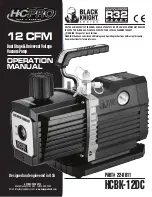
Problem – Operating pressure switch open alternatively high hot gas temperature
Cause
Troubleshooting
Remedy
1. Operating pressure
switch, function.
1. Switch off the main switch for the heat pump, wait
until the compressor has been stationary for at least
15 minutes.
2. Disconnect the two cables on the pressure switch, us-
ing a buzzer check if the pressure switch is closed.
If the pressure switch is closed, bridge the
pressure switch cables temporarily and
switch on the voltage to the heat pump
again. If there is an indication 0 (zero) in the
display this means that the pressure switch
is fault-free and the problem is in the wiring
or in the circuit board.
If the pressure switch is open, try carefully
tapping the head of the pressure switch
with a screwdriver and use a buzzer test to
see if it has closed again.
Replace the pressure switch if it appears to
jam repeatedly.
2. Fault in the discharge
pipe sensor.
Check what the discharge pipe sensor shows. Is it a plausi-
ble/actual value?
Measure the resistance of the discharge pipe sensor, check
against the ohm table in Measurement points .
If the discharge pipe sensor is defective, re-
place it.
3. Hot gas temperature too
high.
The discharge pipe sensor displays more than 140°C. See
operating data.
The square symbol appears when the deliv-
ery pipe temperature is as high or greater
than the maximum temperature of the dis-
charge pipe 140°C.
4. Lack of refrigerant, not
enough refrigerant in the
system.
Using manometer apparatus and thermometer, check that
the unit’s overheating is correct for the specific refrigerant.
Follow the correct procedure (depending
on type of refrigerant) to add the correct
amount of refrigerant.
If there appears to be a leak in the refriger-
ant circuit, carry out leak tracing and any
necessary corrective action. If leak tracer is
not available, brush soap water on the sus-
pected leak and look for bubbles. Also
check for oil as this can come out from the
refrigerant circuit.
3.5.2
Leakage
Problem – Leak fluid side
Cause
Troubleshooting
Remedy
1. Insufficiently tightened
connections.
Locate the leak.
▪
Tighten the connection and check that
it is sealed.
▪
If it is still not sealed, replace the entire
connection and support sleeve (only
at soft pipes).
2. Defective gasket or O-
ring.
Locate the leak.
Replace the gasket or O-ring.
3. Cracked nut or connec-
tion.
Locate the leak.
Replace nut or connection.
4. There is no overflow pipe
connected to the safety
valve(s).
Establish which safety valve does not have an overflow
pipe.
Install an overflow pipe according to the
applicable norms.
5. Filler valve between in-
coming cold water and
heating system not closed
or leaking.
Check whether water continuously leaks from the safety
valve on the expansion vessel on the hot side.
Try closing the filler valve and see if water
stops dripping from the safety valve. If not,
replace the filler valve.
Service Instructions
DHP-AQ
VMGFJ202
Danfoss Heating Solutions
20
















































